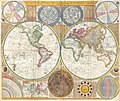File:1794 Samuel Dunn Wall Map of the World in Hemispheres - Geographicus - World2-dunn-1794.jpg

Dimensioni di questa anteprima: 712 × 600 pixel. Altre risoluzioni: 285 × 240 pixel | 570 × 480 pixel | 912 × 768 pixel | 1 216 × 1 024 pixel | 2 431 × 2 048 pixel | 6 000 × 5 054 pixel.
File originale (6 000 × 5 054 pixel, dimensione del file: 8,92 MB, tipo MIME: image/jpeg)
Cronologia del file
Fare clic su un gruppo data/ora per vedere il file come si presentava nel momento indicato.
| Data/Ora | Miniatura | Dimensioni | Utente | Commento | |
|---|---|---|---|---|---|
| attuale | 22:01, 1 giu 2012 |  | 6 000 × 5 054 (8,92 MB) | Brandmeister~commonswiki | Reverted to version as of 04:17, 23 March 2011 |
| 18:15, 19 mag 2012 |  | 6 000 × 5 054 (27,38 MB) | Brandmeister~commonswiki | contrast | |
| 06:17, 23 mar 2011 |  | 6 000 × 5 054 (8,92 MB) | BotMultichillT | {{subst:User:Multichill/Geographicus |link=http://www.geographicus.com/P/AntiqueMap/World2-dunn-1794 |product_name=1794 Samuel Dunn Wall Map of the World in Hemispheres |map_title=A General Map of the World, or Terraqueouis Globe with all the New Discover |
Utilizzo del file
La seguente pagina usa questo file:
Utilizzo globale del file
Anche i seguenti wiki usano questo file:
- Usato nelle seguenti pagine di alt.wikipedia.org:
- Usato nelle seguenti pagine di ar.wikipedia.org:
- Usato nelle seguenti pagine di av.wikipedia.org:
- Usato nelle seguenti pagine di br.wiktionary.org:
- Usato nelle seguenti pagine di ckb.wikipedia.org:
- Usato nelle seguenti pagine di cv.wikipedia.org:
- Usato nelle seguenti pagine di de.wikipedia.org:
- Usato nelle seguenti pagine di en.wikipedia.org:
- Early world maps
- History of cartography
- Southern Ocean
- Samuel Dunn (mathematician)
- Wikipedia:Featured picture candidates/1794 Samuel Dunn Map
- A General Map of the World, or Terraqueous Globe
- Wikipedia:Featured picture candidates/June-2012
- User:Cruickshanks/sandbox2
- Wikipedia:Featured picture candidates/March-2014
- Wikipedia:Featured picture candidates/1794 Samuel Dunn Wall Map of the World in Hemispheres - Geographicus - World2-dunn-1794.jpg (review)
- User:Setvina/be bold
- Portal:Maps
- User:Sarangem
- User:Jacobwilder427
- Usato nelle seguenti pagine di en.wiktionary.org:
- Usato nelle seguenti pagine di eo.wikipedia.org:
- Usato nelle seguenti pagine di et.wikipedia.org:
- Usato nelle seguenti pagine di eu.wikipedia.org:
- Usato nelle seguenti pagine di fa.wikipedia.org:
- ویکیپدیا:نگارههای برگزیده/نقشه
- ویکیپدیا:گزیدن نگاره برگزیده/ژوئن-۲۰۱۲
- نقشه ساموئل دان
- ویکیپدیا:گزیدن نگاره برگزیده/1794 Samuel Dunn Wall Map of the World in Hemispheres - Geographicus - World2-dunn-1794.jpg
- ویکیپدیا:نگاره روز/اکتبر ۲۰۱۲
- الگو:نر/2012-10-03
- الگو:نر محافظت شده/2012-10-03
- بحث کاربر:Alborzagros/بایگانی ۷
- Usato nelle seguenti pagine di fr.wikipedia.org:
- Usato nelle seguenti pagine di fr.wikiversity.org:
- Usato nelle seguenti pagine di gl.wikipedia.org:
- Usato nelle seguenti pagine di hu.wikipedia.org:
- Usato nelle seguenti pagine di hy.wikipedia.org:
Visualizza l'utilizzo globale di questo file.


